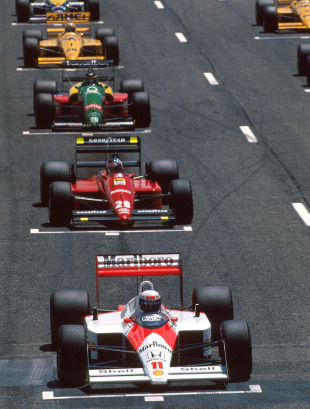JAPAN'S REGIONS

Monday, July 25, 2011
THIS PASTOR CAN PRAY
NASCAR pastor leaves little out of this pre-race invocation!
posted by Rob Kerby, Senior Editor | 8:55 am Monday July 25, 2011
Before Saturday night’s Nationwide Federated Auto Parts 300, Pastor Joe Nelms of Nashville’s Family Baptist Church was asked to pray. And pray, he did!
Before the NASCAR crowd at Nashville Superspeedway Nelms notes that God tells us to be thankful for all things — and then goes on to thank the Almighty for “these mighty machines that you brought before us. Thank you for the Dodges and Toyotas. Thank you for the Fords and most of all we thank you for Roush and Yates partnering to give us the power we see before us tonight.
Thank you for GM Performance Technology and R07 engines. Thank you for Sunoco racing fuel and Goodyear tires that bring performance and power to the track. Lord, I want to thank you for my smokin’ hot wife …’’
The respectful crowd begins to suspect something is up about the time he starts thanking God for Sonoco racing fuel. Drivers can be seen looking up and chuckling. But the line about his smokin’ hot wife – a line from the movie “Talladega Nights’’ brings the house down. The crowd roars — but with the cadence of a Southern preacher, Nelm’s voice rises in magnitude as he continues past “for my smokin’ hot wife tonight, Lisa,” and includes his kids: ”and my two children, Eli and Emma, or as we like to call them, ‘The Little E’s.’ ”
Perhaps the most unforgettable line of the prayer comes when Nelms quotes NASCAR Hall of Famer Darrell Waltrip at the end of his prayer.
“In Jesus’ name, Boogity Boogity Boogity, amen,” Nelms proclaims.
Race winner Carl Edwards appreciated the humor that came with Nelms’ prayer.
“I turned to Jack (Roush) after that. I said, ‘If anything happens, I want him to be at my funeral.’ That was one of the best invocations I have ever heard.”
Thursday, February 3, 2011
Kung Hey Fat Choi!
In the Chinese calendar,
today marks the start of the Year of the Rabbit,
Find out what else to expect.
Monday, November 29, 2010
GM Introduces New E-Rod Crate Engines at SEMA
GM Performance Products announced at the 2010 SEMA Show that it has added three new E-Rod packages that are designed for hot rodders to its E-Rod line of crate engines. The company introduced the original E-Rod LS3 crate engine at last year’s SEMA Show.
The first of the new packages, the E-Rod 5.3L, is an entry-level option that features an engine from the Silverado pickup truck. It produces 315 horsepower and 335 lbs./f.t of torque with camshaft phasing, according to the company.
The engine was used to power the E-Rod ’55 Chevy pickup found in GM’s booth at the SEMA Show.
The second new package, the E-Rod LS7, features an engine from the Corvette Z06 and offers 505 horsepower.
The E-Rod LSA package features the supercharged 6.2-liter V-8 engine from the Cadillac CTS-V. It offers 556 horsepower and 551 lbs./ft. of torque. In addition, the LSA comes with a conventional wet-sump lubrication system. Other features of the LSA package include a unique aluminum-cylinder block casting that houses a forged steel crankshaft, integrated piston cooling oil jets, high-flow cylinder heads and relatively mild camshaft, according to the company. This package was used in a Superformance Corvette Grand Sport coupe that was seen on the SEMA Show floor.
All of the E-Rods are available for manual and automatic gearboxes. The packages include a wiring harness, ECU, exhaust manifolds, catalytic converter, oxygen sensors, mass airflow sensor, accelerator pedal, air filter and instruction manual.
The 5.3L and LSA engine packages are available now; the LS7 package is slated to be released for sale early in 2011.
For more information on the new E-Rod crate engines, go tohttp://www.gmperformanceparts.com/.
The first of the new packages, the E-Rod 5.3L, is an entry-level option that features an engine from the Silverado pickup truck. It produces 315 horsepower and 335 lbs./f.t of torque with camshaft phasing, according to the company.
The engine was used to power the E-Rod ’55 Chevy pickup found in GM’s booth at the SEMA Show.
The second new package, the E-Rod LS7, features an engine from the Corvette Z06 and offers 505 horsepower.
The E-Rod LSA package features the supercharged 6.2-liter V-8 engine from the Cadillac CTS-V. It offers 556 horsepower and 551 lbs./ft. of torque. In addition, the LSA comes with a conventional wet-sump lubrication system. Other features of the LSA package include a unique aluminum-cylinder block casting that houses a forged steel crankshaft, integrated piston cooling oil jets, high-flow cylinder heads and relatively mild camshaft, according to the company. This package was used in a Superformance Corvette Grand Sport coupe that was seen on the SEMA Show floor.
All of the E-Rods are available for manual and automatic gearboxes. The packages include a wiring harness, ECU, exhaust manifolds, catalytic converter, oxygen sensors, mass airflow sensor, accelerator pedal, air filter and instruction manual.
The 5.3L and LSA engine packages are available now; the LS7 package is slated to be released for sale early in 2011.
For more information on the new E-Rod crate engines, go tohttp://www.gmperformanceparts.com/.
Tuesday, November 9, 2010
2010 SEMA Show: From Hot Rods to Exotics to Hybrids
November 4, 2010, 12:37 PM
By JERRY GARRETT Jerry Garrett for The New York TimesThis naked steel sled in Hot Rod Alley may have drawn the most attention at the SEMA Show in Las Vegas. More photos.
Jerry Garrett for The New York TimesThis naked steel sled in Hot Rod Alley may have drawn the most attention at the SEMA Show in Las Vegas. More photos.
By JERRY GARRETT

The annual Specialty Equipment Market Association trade show in Las Vegas is an opportunity for companies selling aftermarket automotive accessories to let their imaginations run wild. Refinish a Rolls-Royce in black primer? Hot-rod a hybrid? Is one engine enough? Why not two? There are no limits. Nearly one million square feet of exhibit space inside the Las Vegas Convention Center is packed with one display after another, and aisles that seem to stretch for miles; what there is no room for inside spills out into the parking lots, to the nearby Sands Convention Center, and even various casinos.
The show, which is not open to the general public, officially lasts four days, Nov. 2-5. Unofficially, automotive tinkering never ends.
Saturday, October 30, 2010
Pontiac Falls From Muscle Car Glory to Graveyard
By NICK BUNKLEY
Gary McCracken for The New York Times
The last new Pontiac for sale on the lot at Lee Pontiac GMC in Fort Walton Beach , Fla.
It was 84 years old. The cause of death was in dispute. Fans said Pontiac Pontiac built its last car nearly a year ago, but the official end was set for Oct. 31, when G.M.’s agreements with Pontiac
“They were C.P.R.-ing a corpse for a long time,” said Larry Kummer, a retired graphic artist who has owned more than two dozen Pontiacs
The G.M. brand that was advertised for “driving excitement,” Pontiac
Its biggest triumph was the GTO, developed by Mr. DeLorean, the brand’s rebellious chief engineer, in violation of a G.M. policy dictating the maximum size of a car’s engine. The GTO was a hit, and the age of the muscle car had begun.
“When the muscle-car era was in its heyday, Pontiac was king,” said Frederick Perrine, a dealer in Cranbury , N.J. , whose family sold Pontiacs
Ed Dieffenbach, a retired police officer, recalls admiring Pontiacs Miami to the Lee Pontiac GMC dealership in Florida
“I always wanted a hot rod, but never got around to it, so this is it,” Mr. Dieffenbach, 62, said after getting his new car home. “My wife sat in it last night and said, ‘Oh my Lord, wow.’ ”
For most of the 1960s, Pontiac ranked third in sales behind Chevy and Ford — a position now held by Toyota.
But in the decades since, Pontiac
By early 2009, Pontiac had fallen to 12th place in the United States
“They had a lot of glory years, but from the ’70s on, Pontiac
For the most part, Pontiac Pontiacs
“You hate to see them go, but they were floundering and couldn’t find their place in the market,” said Tim Dye, who owns 21 Pontiacs from various eras and a huge collection of Pontiac
Mr. Dye’s home in Oklahoma, along with two buildings on his property, are filled with thousands of items from Pontiac’s past, including showroom brochures, advertising posters, model cars, pencils, ashtrays and matchbooks. Now that Pontiac is gone, Mr. Dye plans to turn his collection into a museum in Pontiac , Ill.
“I can’t think of anything better to do than just visit with people about Pontiac
The Pontiac Motor Division was born at G.M. in 1926 as a single model under the Oakland brand, but its roots date to the 1890s, when horse-drawn carriage-making was a big industry in Pontiac , 25 miles northwest of Detroit
G.M.’s first Pontiac Oakland to focus on Pontiacs
Mr. Knudsen, known as Bunkie, was once quoted describing wide-track Pontiacs Pontiac
No innovation did as much for Pontiac Pontiac
“We got 5,000 of them out into the marketplace before we got around to telling the corporation what we were doing,” said Jim Wangers, a Pontiac
Mr. Wangers, who was born the same year as Pontiac
But Pontiac Pontiac
Gary Lee Jr., an owner of the dealership that sold Mr. Dieffenbach his Solstice this week, remembers the sadness of losing Oldsmobile when G.M. killed that brand in 2004. But with Pontiac Pontiac at his dealership had long been removed, and he said, thankfully, he had no more new Pontiacs
“It was a great line,” Mr. Lee said, “while it lasted.”
· Collecting: When Bigger Was Better, Pontiac Was a Winner(December 20, 2009)
· When Pontiac Meant Muscle(May 3, 2009)
· Its Muscle Car Glory Faded, Pontiac Shrivels Up (February 20, 2009)
Tuesday, October 12, 2010
Friday, September 24, 2010
Pirelli Celebrates F1 Tyre Factory Inauguration
 On September 23 Pirelli officially inaugurated what it calls the “Factory of Champions” at its plant in Izmit, Turkey, where the company will produce tyres for all Formula One teams during the 2011 to 2013 seasons. The inauguration served as a double celebration for Pirelli, as 2010 marks the 50th anniversary of the Izmit facility’s opening and the Italian tyre maker’s operations in Turkey.
On September 23 Pirelli officially inaugurated what it calls the “Factory of Champions” at its plant in Izmit, Turkey, where the company will produce tyres for all Formula One teams during the 2011 to 2013 seasons. The inauguration served as a double celebration for Pirelli, as 2010 marks the 50th anniversary of the Izmit facility’s opening and the Italian tyre maker’s operations in Turkey.Producing eight million tyres for cars, trucks and motorsport each year, Izmit has the largest unit output of any Pirelli tyre. The group has invested 140 million euros there over the last ten years and plans to invest a further 30 million euros in 2011 to support expansion in Turkey and nearby emerging markets. The Izmit site has housed Pirelli’s motorsport tyre production line since 2007 and, in synergy with the company’s research and development centre in Milan, will become the heart of Pirelli’s Formula One activities.
Thursday, September 23, 2010
Driver Chooses Infinity Tyres for Dutch Drifting

Oliver Harrsch drives a BMW E-30 powered by a 3.6 Litre engine from an M5 BMW
and equipped with Infinity 050 UHP tyres
Drifting driver Oliver Harrsch recently competed in a round of the Dutch Open Drift Championship held in Kalkar, Germany (held 11 - 12 September) equipped with Infinity tyres. Harrsch was supplied the tyres by Venlo-based Infinity distributor Euro-Tyre and according to the company, the small and technical course was suited to lower powered cars and the more skilled drivers. On the first day, dry conditions allowed Harrsch to push the Infinity 050 UHP tyres to their limits and to experiment with tyre pressures. He commented: “Lots of grip and very smokey! Infinity are unbelievably good tyres!" In extremely wet conditions on the second day, Oliver took a very commendable fourth position...
Tuesday, September 14, 2010
Brembo Plans Brake Plant in Czech Republic
Italian brake product maker Brembo has announced plans to build a new production plant in the Czech Republic. The three-year, 35 million euro project will start operations in 2011. The project included rehabilitating an existing industrial building in the city of Ostrava, Brembo said.
Brake calipers and other aluminum components will be cast, machined and assembled there, Brembo said, and it plans to develop an “integrated industrial center supplying quality brake systems with a high technological content to the European market.”
Brembo Czech s.r.o. is expected to achieve sales turnover of around 55 million euros in 2014, generated through new business through the new plant.
Brake calipers and other aluminum components will be cast, machined and assembled there, Brembo said, and it plans to develop an “integrated industrial center supplying quality brake systems with a high technological content to the European market.”
Brembo Czech s.r.o. is expected to achieve sales turnover of around 55 million euros in 2014, generated through new business through the new plant.
Sunday, September 12, 2010
Industry News
Borla Performance Industries announced the merger of TWM Induction into the Borla Performance group of companies. According to a release, the merger enables the two companies to leverage their collective 60 years of experience to design, manufacture, market and sell induction and exhaust systems worldwide. TWM Induction, originally based in Goleta, California, has moved into the 320,000-sq.-ft. headquarters of Borla Performance, located in Johnson City, Tennessee. Borla and TWM Induction have supplied racing teams, classic car enthusiasts and speed fans with their world-class engineering expertise and personalized approach. A joint operation named Borla Induction will soon launch, introducing a new line of late-model products
Tuesday, September 7, 2010
A new formula for 2013 emerges

Turbos have been banned in F1 since 1989 © Sutton Images
Enlarge
Details of Formula One's radical new regulations for 2013 have begun to emerge, although they will not be confirmed until later this year.
The sport is set for a major overhaul to introduce more efficient engines, ground-effect aerodynamics and road-relevant technologies to F1 cars.
According to GP Week the teams have agreed to adopt 1.6 litre, 4 cylinder turbo engines, limited to 10,000 rpm and producing approximately 650bhp. The new engines will be mated to kinetic energy recovery systems, capable of producing a further 150bhp power boost. A fuel flow rate limit will also be introduced to ensure the engines are frugal compared to the current crop of 2.4 litre V8s.
To reduce drag engineers will be allowed to reintroduce ground-effect aerodynamics - pioneered in the 1970s but banned due to safety concerns. Sidepods will also be moved forwards to increase driver protection, while the size of the wheel rims is expected to increase in future years.
The basis of the 2013 rules are likely to be outlined in more detail after a forthcoming meeting of the World Motor Sport Council.
Subscribe to:
Posts (Atom)

























